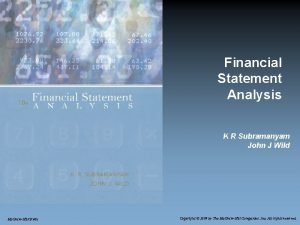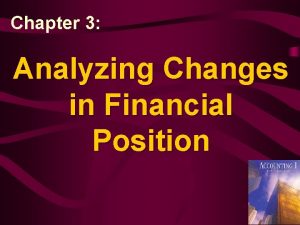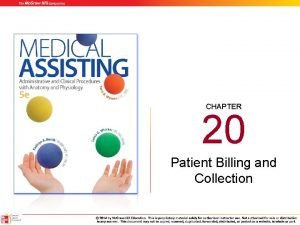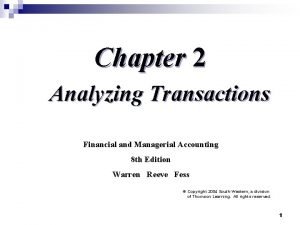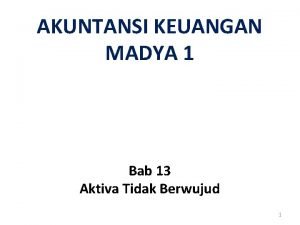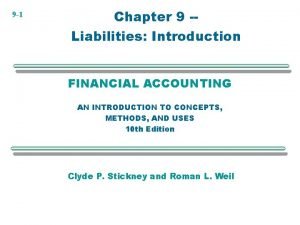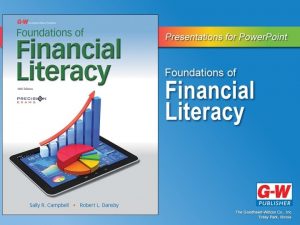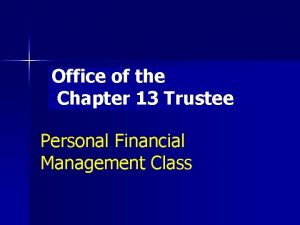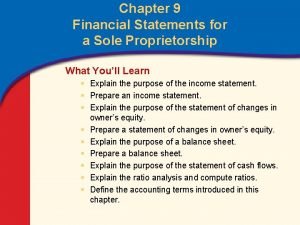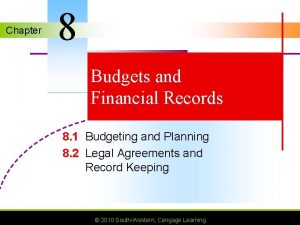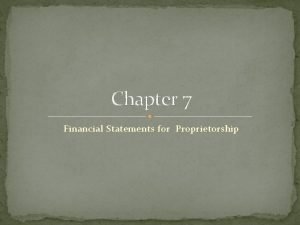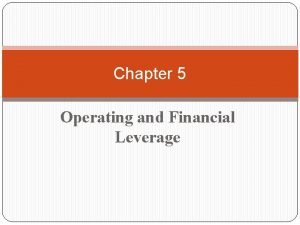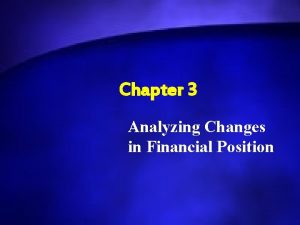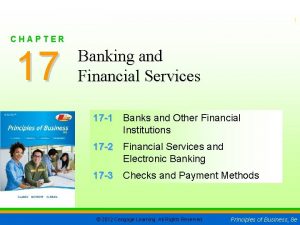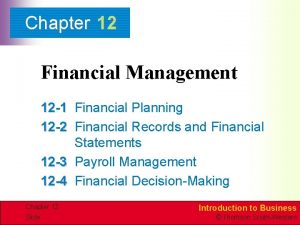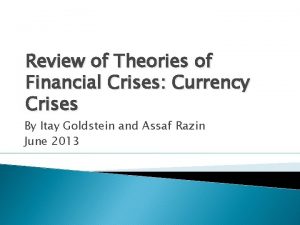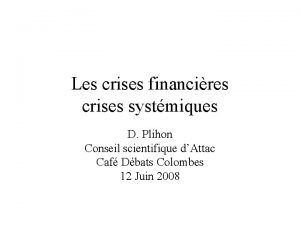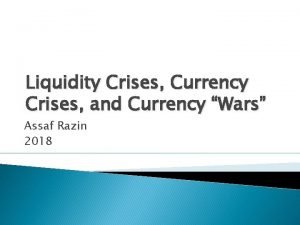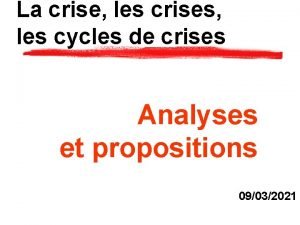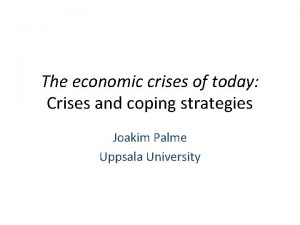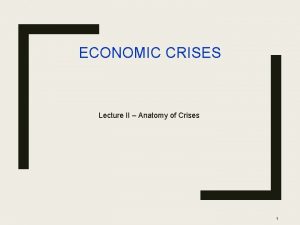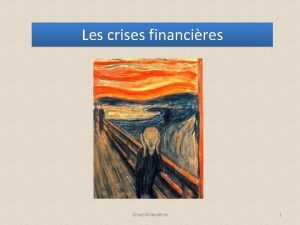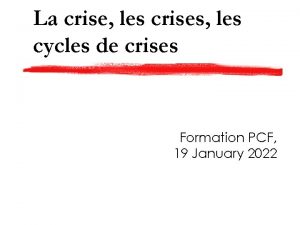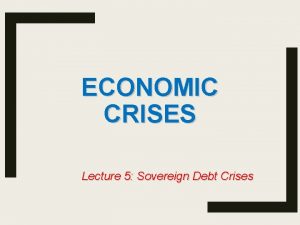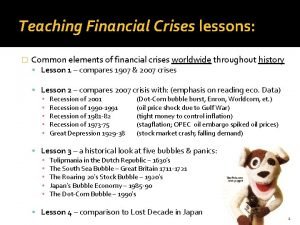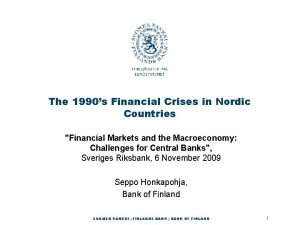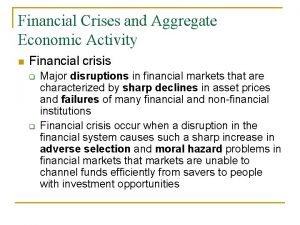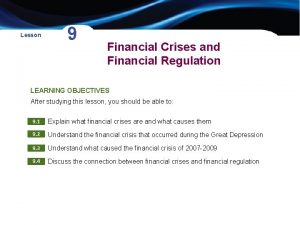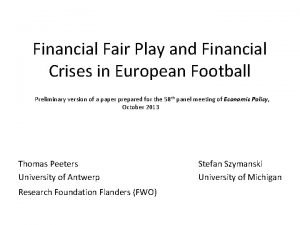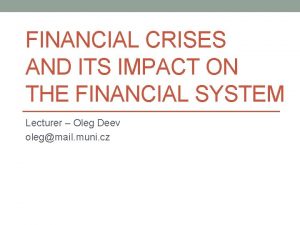Chapter 9 Financial Crises What is a Financial






























- Slides: 30

Chapter 9 Financial Crises

What is a Financial Crisis? • A financial crisis occurs when there is a particularly large disruption to information flows in financial markets, with the result that financial frictions increase sharply and financial markets stop functioning • Asset Markets Effects on Balance Sheets – Stock market decline • Decreases net worth of corporations. – Unanticipated decline in the price level • Liabilities increase in real terms and net worth decreases. – Unanticipated decline in the value of the domestic currency • Increases debt denominated in foreign currencies and decreases net worth. – Asset write-downs. 9 -2 © 2013 Pearson Education, Inc. All rights reserved.

Factors Causing Financial Crises • Deterioration in Financial Institutions’ Balance Sheets – Decline in lending. • Banking Crisis – Loss of information production and disintermediation. • Increases in Uncertainty – Decrease in lending. 9 -3 © 2013 Pearson Education, Inc. All rights reserved.

Factors Causing Financial Crises (cont’d) • Increases in Interest Rates – Increases adverse selection problem – Increases need for external funds and therefore adverse selection and moral hazard. • Government Fiscal Imbalances – Create fears of default on government debt. – Investors might pull their money out of the country. 9 -4 © 2013 Pearson Education, Inc. All rights reserved.

Dynamics of Financial Crises in Advanced Economies • Stage One: Initiation of Financial Crisis – Mismanagement of financial liberalization/innovation – Asset price boom and bust – Spikes in interest rates – Increase in uncertainty • Stage two: Banking Crisis • Stage three: Debt Deflation 9 -5 © 2013 Pearson Education, Inc. All rights reserved.

Figure 1 Sequence of Events in Financial Crises in Advanced Economies 9 -6 © 2013 Pearson Education, Inc. All rights reserved.

APPLICATION The Mother of All Financial Crises: The Great Depression • How did a financial crisis unfold during the Great Depression and how it led to the worst economic downturn in U. S. history? • This event was brought on by: – – 9 -7 Stock market crash Bank panics Continuing decline in stock prices Debt deflation © 2013 Pearson Education, Inc. All rights reserved.

Figure 2 Stock Price Data During the Great Depression Period Source: Dow-Jones Industrial Average (DJIA). Global Financial Data; www. globalfinancialdata. com/index_tabs. php? action=detailedinfo&id=1165. 9 -8 © 2013 Pearson Education, Inc. All rights reserved.

Figure 3 Credit Spreads During the Great Depression Source: Federal Reserve Bank of St. Louis FRED database; http: //research. stlouisfed. org/fred 2/categories/22. 9 -9 © 2013 Pearson Education, Inc. All rights reserved.

Application: The Global Financial Crisis of 2007 -2009 • Causes: • Financial innovations emerge in the mortgage markets – Subprime and Alt-A mortgages – Mortgage-backed securities – Collateralized debt obligations (CDOs) • Housing price bubble forms – Increase in liquidity from cash flows surging to the United States 9 -10 © 2013 Pearson Education, Inc. All rights reserved.

Application: The Global Financial Crisis of 2007 - 2009 (cont’d) • Housing price bubble forms (cont’d) – Development of subprime mortgage market fueled housing demand housing prices. • Agency problems arise – “Originate to distribute” model is subject to principal (investor) agent (mortgage broker) problem. – Borrowers had little incentive to disclose information about their ability to pay 9 -11 © 2013 Pearson Education, Inc. All rights reserved.

Application: The Global Financial Crisis of 2007 - 2009 (cont’d) • Agency problems arise (cont’d) – Commercial and investment banks (as well as rating agencies) had weak incentives to assess the quality of securities • Information problems surface • Housing price bubble bursts 9 -12 © 2013 Pearson Education, Inc. All rights reserved.

Application: The Global Financial Crisis of 2007 - 2009 (cont’d) • Crisis spreads globally – Sign of the globalization of financial markets – TED spread (3 months interest rate on Eurodollar minus 3 months Treasury bills interest rate) increased from 40 basis points to almost 240 in August 2007. 9 -13 © 2013 Pearson Education, Inc. All rights reserved.

Application: The Global Financial Crisis of 2007 - 2009 (cont’d) • Banks’ balance sheets deteriorate – Write downs – Sell of assets and credit restriction • High-profile firms fail – Bear Stearns (March 2008) – Fannie Mae and Freddie Mac (July 2008) – Lehman Brothers, Merrill Lynch, AIG, Reserve Primary Fund (mutual fund) and Washington Mutual (September 2008). 9 -14 © 2013 Pearson Education, Inc. All rights reserved.

Application: The Global Financial Crisis of 2007 - 2009 (cont’d) • Bailout package debated – House of Representatives voted down the $700 billion bailout package on September 29, 2008. – It passed on October 3. • Recovery in sight? – Congress approved a $787 billion economic stimulus plan on February 13, 2009. 9 -15 © 2013 Pearson Education, Inc. All rights reserved.

FYI Collateralized Debt Obligations (CDOs) • The creation of a collateralized debt obligation involves a corporate entity called a special purpose vehicle (SPV) that buys a collection of assets such as corporate bonds and loans, commercial real estate bonds, and mortgage-backed securities • The SPV separates the payment streams (cash flows) from these assets into buckets that are referred to as tranches 9 -16 © 2013 Pearson Education, Inc. All rights reserved.

FYI Collateralized Debt Obligations (CDOs) (cont’d) • The highest rated tranches, referred to as super senior tranches are the ones that are paid off first and so have the least risk • The lowest tranche of the CDO is the equity tranche and this is the first set of cash flows that are not paid out if the underlying assets go into default and stop making payments. This tranche has the highest risk and is often not traded 9 -17 © 2013 Pearson Education, Inc. All rights reserved.

Figure 4 Housing Prices and the Financial Crisis of 2007– 2009 Source: Case-Shiller U. S. National Composite House Price Index; www. macromarkets. com/csi_housing/index. asp. 9 -18 © 2013 Pearson Education, Inc. All rights reserved.

Inside the Fed Was the Fed to Blame for the Housing Price Bubble? • Some economists have argued that the low rate interest policies of the Federal Reserve in the 2003– 2006 period caused the housing price bubble • Taylor argues that the low federal funds rate led to low mortgage rates that stimulated housing demand encouraged the issuance of subprime mortgages, both of which led to rising housing prices and a bubble 9 -19 © 2013 Pearson Education, Inc. All rights reserved.

Inside the Fed Was the Fed to Blame for the Housing Price Bubble? (cont’d) • Federal Reserve Chairman Bernanke countered this argument, saying the culprits were the proliferation of new mortgage products that lowered mortgage payments, a relaxation of lending standards that brought more buyers into the housing market, and capital inflows from emerging market countries • The debate over whether monetary policy was to blame for the housing price bubble continues to this day. 9 -20 © 2013 Pearson Education, Inc. All rights reserved.

Figure 5 Stock Prices and the Financial Crisis of 2007– 2009 Source: Dow-Jones Industrial Average (DJIA). Global Financial Data; www. globalfinancialdata. com/index_tabs. php? action=detailedinfo&id=1165. 9 -21 © 2013 Pearson Education, Inc. All rights reserved.

Figure 6 Credit Spreads and the 2007 – 2009 Financial Crisis Source: Federal Reserve Bank of St. Louis FRED database; http: //research. stlouisfed. org/fred 2/categories/22. 9 -22 © 2013 Pearson Education, Inc. All rights reserved.

Dynamics of Financial Crises in Emerging Market Economies • Stage one: Initiation of Financial Crisis. – Path one: mismanagement of financial liberalization/globalization: • Weak supervision and lack of expertise leads to a lending boom. • Domestic banks borrow from foreign banks. • Fixed exchange rates give a sense of lower risk. • Banks play a more important role in emerging market economies, since securities markets are not well developed yet. 9 -23 © 2013 Pearson Education, Inc. All rights reserved.

Dynamics of Financial Crises in Emerging Market Economies (cont’d) – Path two: severe fiscal imbalances: • Governments in need of funds sometimes force banks to buy government debt. • When government debt loses value, banks lose and their net worth decreases. – Additional factors: • Increase in interest rates (from abroad) • Asset price decrease • Uncertainty linked to unstable political systems 9 -24 © 2013 Pearson Education, Inc. All rights reserved.

Dynamics of Financial Crises in Emerging Market Economies (cont’d) • Stage two: currency crisis – Deterioration of bank balance sheets triggers currency crises: • Government cannot raise interest rates (doing so forces banks into insolvency)… • … and speculators expect a devaluation. – How severe fiscal imbalances triggers currency crises: • Foreign and domestic investors sell the domestic currency. 9 -25 © 2013 Pearson Education, Inc. All rights reserved.

Dynamics of Financial Crises in Emerging Market Economies (cont’d) • Stage three: Full-Fledged Financial Crisis: – The debt burden in terms of domestic currency increases (net worth decreases). – Increase in expected and actual inflation reduces firms’ cash flow. – Banks are more likely to fail: • Individuals are less able to pay off their debts (value of assets fall). • Debt denominated in foreign currency increases (value of liabilities increase). 9 -26 © 2013 Pearson Education, Inc. All rights reserved.

Figure 7 Sequence of Events in Emerging Market Financial Crises 9 -27 © 2013 Pearson Education, Inc. All rights reserved.

APPLICATION Financial Crises in Mexico, 1994– 1995; East Asia, 1997– 1998; and Argentina, 2001– 2002 • Mexico: Financial liberalization in the early 1990 s: – Lending boom, coupled with weak supervision and lack of expertise. – Banks accumulated losses and their net worth declined. • Rise in interest rates abroad. • Uncertainty increased (political instability). • Domestic currency devaluated on December 20, 1994. • Rise in actual and expected inflation. 9 -28 © 2013 Pearson Education, Inc. All rights reserved.

APPLICATION Financial Crises in Mexico, 1994– 1995; East Asia, 1997– 1998; and Argentina, 2001– 2002 (cont’d) • East Asia: Financial liberalization in the early 1990 s: – Lending boom, coupled with weak supervision and lack of expertise. – Banks accumulated losses and their net worth declined. • Uncertainty increased (stock market declines and failure of prominent firms). • Domestic currencies devaluated by 1997. • Rise in actual and expected inflation. 9 -29 © 2013 Pearson Education, Inc. All rights reserved.

APPLICATION Financial Crises in Mexico, 1994– 1995; East Asia, 1997– 1998; and Argentina, 2001– 2002 (cont’d) • Argentina: Government coerced banks to absorb large amounts of debt due to fiscal imbalances. • Rise in interest rates abroad. • Uncertainty increased (ongoing recession). • Domestic currency devaluated on January 6, 2002 • Rise in actual and expected inflation. 9 -30 © 2013 Pearson Education, Inc. All rights reserved.
 The crises
The crises Meervoud van cactus
Meervoud van cactus Financial methods of motivation definition
Financial methods of motivation definition Why study financial markets?
Why study financial markets? Chapter 14 financial statement analysis solutions
Chapter 14 financial statement analysis solutions Financial statement analysis subramanyam ppt chapter 2
Financial statement analysis subramanyam ppt chapter 2 Financial accounting chapter 1
Financial accounting chapter 1 Financial management chapter 8 risk and return
Financial management chapter 8 risk and return Chapter 4 financial decisions and planning
Chapter 4 financial decisions and planning Chapter 4 financial decisions and planning
Chapter 4 financial decisions and planning Financial statements and ratio analysis chapter 3
Financial statements and ratio analysis chapter 3 Financial decision-making process
Financial decision-making process Equation analysis sheet
Equation analysis sheet Chapter 26 saving investment and the financial system
Chapter 26 saving investment and the financial system Chapter 20 patient collections and financial management
Chapter 20 patient collections and financial management Conceptual framework for financial reporting
Conceptual framework for financial reporting Financial accounting chapter 2 solutions
Financial accounting chapter 2 solutions Financial accounting chapter 13
Financial accounting chapter 13 Financial accounting chapter 6
Financial accounting chapter 6 The expense recognition principle aims to record
The expense recognition principle aims to record Financial accounting chapter 9
Financial accounting chapter 9 Chapter 1 financial literacy basics
Chapter 1 financial literacy basics Chapter 13 personal financial management course
Chapter 13 personal financial management course Financial statement of sole proprietorship
Financial statement of sole proprietorship Chapter 8 budgets and financial records
Chapter 8 budgets and financial records Sole proprietorship financial statements
Sole proprietorship financial statements Operating and financial leverage
Operating and financial leverage Chapter 3 analyzing changes in financial position answers
Chapter 3 analyzing changes in financial position answers Chapter 17 banking and financial services
Chapter 17 banking and financial services Chapter 14 financial statement analysis solutions
Chapter 14 financial statement analysis solutions Chapter 12 financial management
Chapter 12 financial management





